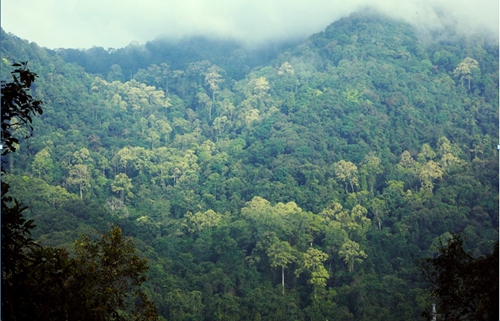Given the generality of species abundance distributions ( SADs), ecologists have frequently focused their research on the shape of SADs and where species fall in the SAD. In this regard, trait-based analyses of abundance distributions have had mixed success. Such work typically focuses on correlating species mean trait values with abundance. Researchers from University of Maryland and Xishuangbanna Tropical Botanical Garden (XTBG) have taken an alternative approach that considered how intraspecific variation in traits and growth rates were linked to abundance. Their aim was to provide novel insights into the mechanisms underlying patterns of commonness and rarity in tropical tree communities.
The researchers used data from 1974 seedling individuals of 142 species in a tropical rainforest in Xishuangbanna, Yunnan, China (101°34′ E, 21°36′N) and 1771 seedling individuals of 53 species in a tropical rain forest in the El Yunque National Forest, in Puerto Rico (65°47′W, 18°19′N). Those seedlings were monitored during one year for growth in 218 and 200 plots, respectively, and then harvested for trait measurements.
By using the data, the researchers asked what the relationship was between intraspecific trait variation and relative abundance and how intraspecific growth rate variation was related with relative abundance. They tested whether common species had higher growth rates compared to rare species. They finally asked whether rare species occupied extreme positions of the community trait distribution, while dominant species occupied a core position.
The study found that the degree of intraspecific variation in traits and growth was itself variable across species and negatively related to abundance. Analyses indicated that common species were not necessarily faster growing and in many cases rare species tended to occupy the periphery of trait space. In their study common species were likely to occupy core positions within the total range of traits relevant for acquiring limiting resources and the variance in those traits was usually less than that found in rarer species.
The researchers thus proposed that common species were well-suited for the available environmental conditions where deviations from their optimal trait values were detrimental. However, rare species were likely to be transient species ill-suited to available conditions and exhibiting high phenotypic variation in their struggle for success.
The study entitled “Commonness, rarity, and intraspecific variation in traits and performance in tropical tree seedlings” has been published online in Ecology Letters.
Key words
Tropical forest, species abundance, functional traits, relative growth, variation
Contact
CAO Min, Ph.D Principal Investigator
Key Laboratory of Tropical Forest Ecology, Xishuangbanna Tropical Botanical Garden, Chinese Academy of Sciences, Mengla, Yunnan 666303, China
Tel: 86 871 65160998
E-mail: caom@xtbg.ac.cn

The 20-ha tropical forest plot in Xishuangbanna (Image by LIN Luxiang)

